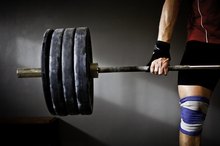Lower Back Pain From Sprinting
Any activity where you don't properly engage the right muscles in the hips, back and stomach can lead to lower back pain. Sprinting is among the many activities that lead to or increase pain located in the lumbar region of the back. Improper foot pronation, or the way your foot turns, may affect lumbar strain. The jumping and jarring associated with sprinting may be another culprit of pain.
If you are experiencing serious medical symptoms, seek emergency treatment immediately.
Initial Response
It is possible to sprain or strain something in your back by training too hard or starting a new exercise program. Back pain that isn't affecting your daily activities significantly, meaning you can still get in and out of bed with ease, may not be a serious problem. Approximately 80 percent of the population experiences back problems at one time or another, with only 10 percent being serious enough to require surgical intervention, notes the American Chiropractic Association. Rest for a few days, icing the affected area, and refrain from sprinting or other jarring sports activities or lifting until the pain subsides. Use anti-inflammatory over-the-counter medications to help with pain and swelling 1.
- It is possible to sprain or strain something in your back by training too hard or starting a new exercise program.
- Rest for a few days, icing the affected area, and refrain from sprinting or other jarring sports activities or lifting until the pain subsides.
Diagnosis
Stretches and Exercises for a Herniated Disc of the Thoracic Spine
Learn More
When dealing with lower lumbar pain present for more than a week, it is important to seek a proper medical diagnosis from your doctor before continuing with your sprinting program or any exercise regimen. While sprinting may be the reason you notice the pain, there may be a significant underlying condition such as a herniated disc, spinal stenosis or degeneration of disk, which creates more significant physical issues. A magnetic resonance imaging, or MRI, machine takes pictures of the spine's bones, nerves and muscles so doctors can properly assess what is causing the problem and how severe it is. Your doctor will let you know when and how aggressively you can return to sprinting.
- When dealing with lower lumbar pain present for more than a week, it is important to seek a proper medical diagnosis from your doctor before continuing with your sprinting program or any exercise regimen.
Sprinting Preparation
Once you are given the OK by your doctor to return to training, it is important to develop a stretching routine that adequately stretches your legs and lower back. Tight hamstrings cause back pain because the imbalance pulls on the hips, straining the lumbar area. Start from the ground up to ensure you are stretching all pertinent muscles when sprinting. If your back has pain or you are concerned, sit on the ground to stretch and touch toes, pull the quadriceps back and raise the hamstrings up to the sky. Sitting reduces the gravitational pull on your back when bending, reducing injury incident. Don't forget to stretch your arms and upper chest area because arm movement is just as important in proper sprinting form.
- Once you are given the OK by your doctor to return to training, it is important to develop a stretching routine that adequately stretches your legs and lower back.
- If your back has pain or you are concerned, sit on the ground to stretch and touch toes, pull the quadriceps back and raise the hamstrings up to the sky.
Work on Form
Mid-Back Pain That Comes & Goes
Learn More
Have your coach or a friend monitor your sprinting form to make sure you are not doing anything to create imbalance or strain. The use of a video camera or a treadmill with mirrors also helps you see form issues, note orthotic and running specialists Wendy Shroeder and Marie-Catherine Bruno. Focus on keeping hips straight without rotation as your legs extend in front of you at the knee. Sprinters bring knees up higher to push down in a more firm fashion compared to distance runners who reach forward with feet for long strides. Shoulders should be relaxed as you throw arms forward as a method of increasing your forward propulsion.
- Have your coach or a friend monitor your sprinting form to make sure you are not doing anything to create imbalance or strain.
- Shoulders should be relaxed as you throw arms forward as a method of increasing your forward propulsion.
Related Articles
References
Writer Bio
With more than 15 years of professional writing experience, Kimberlee finds it fun to take technical mumbo-jumbo and make it fun! Her first career was in financial services and insurance.









